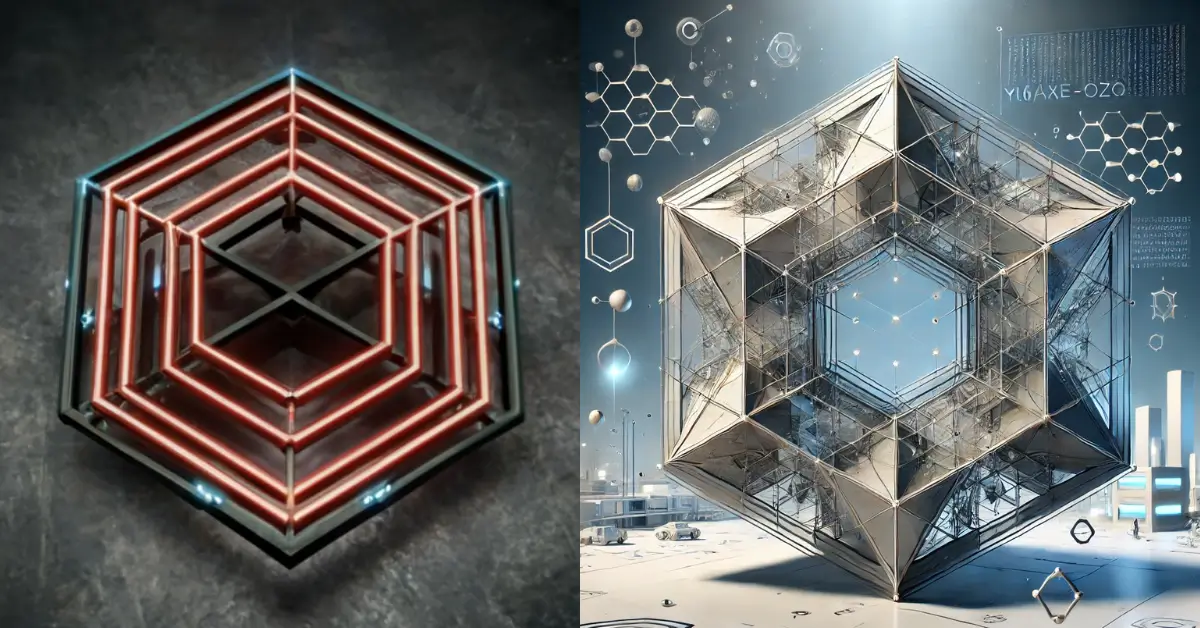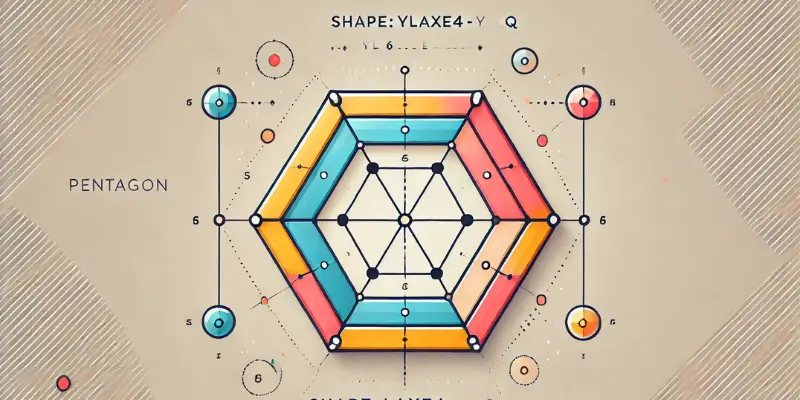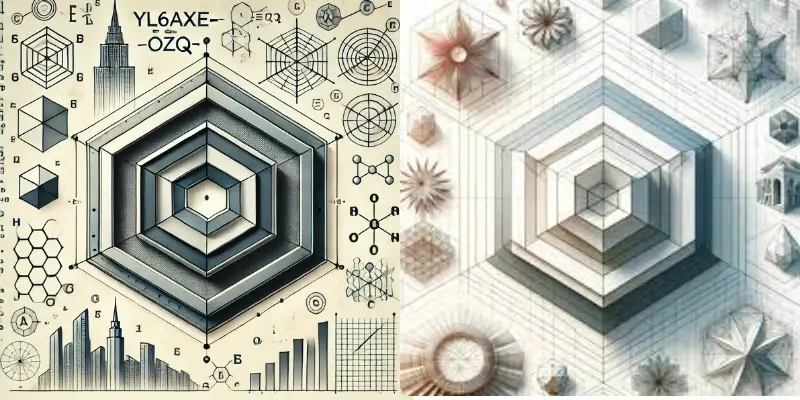shape:yl6axe4-ozq= pentagon: Understanding Its Geometry and Applications

Shape:yl6axe4-ozq= pentagon: Geometry is full of fascinating shapes, each with its own set of properties, meanings, and real-world applications. One such shape that holds great importance across various fields is the pentagon. With its five sides and angles, this geometric form is more than just a classroom concept.
It holds significance in mathematics, architecture, engineering, design, and even nature. This article will explore the pentagon shape in-depth, delving into its mathematical properties, applications in design, and its cultural significance.
In this guide, we will look at both the regular pentagon, with equal sides and angles, and the irregular pentagon, where these attributes may vary. We will also examine the importance of pentagons in different fields, including their use in architectural designs, engineering, and the modern visual world.
As we explore the pentagon’s versatility, you’ll discover why this five-sided shape has stood the test of time.
What is shape:yl6axe4-ozq= pentagon?
The term “pentagon” refers to a geometric shape that is a five-sided polygon, with the word itself derived from the Greek prefix “pente” meaning five, and “gonia” meaning angle. A regular pentagon is characterized by having all five sides of equal length and all interior angles measuring exactly 108 degrees.
An irregular pentagon, on the other hand, can have sides and angles that vary, providing more flexibility in its design. The pentagon shape plays a key role in the study of polygons within geometry. Polygons are closed, flat shapes made of straight lines, and the pentagon is one of the simplest and most recognized examples.
From basic geometry lessons to more complex mathematical properties of pentagons, the shape is a key component in understanding polygon classification and the symmetry of geometric structures.

Mathematical Properties of the Pentagon Shape
In mathematics, the pentagon is not just a shape but a subject of study in geometry and polygon classification. The regular pentagon, with all sides and angles equal, holds a special place in both theoretical and practical applications. One key mathematical property is the fact that the sum of the interior angles of any pentagon is 540 degrees.
This is derived from the general rule for calculating the interior angle sum of a polygon, which is (n-2) * 180°, where n is the number of sides. Another fascinating property of the pentagon is its symmetry.
A regular pentagon has five lines of reflectional symmetry, meaning it can be folded along any of these lines, and the shape will perfectly align on both sides. This symmetry makes the regular pentagon an aesthetically pleasing and balanced figure, often used in design and architecture to convey harmony and proportion.
Read Also: Contactsjet.shop
The Importance of Pentagon in Geometry
The pentagon is a fundamental shape in geometry, especially in the study of polygons. As a five-sided polygon, it provides a straightforward yet insightful example of the properties of polygons, particularly in understanding angles, symmetry, and the relationship between the number of sides and the size of the angles.
For students and professionals alike, the study of pentagons enhances understanding of mathematical properties and how shapes interact within more complex geometric systems. The pentagon shape also serves as a bridge between simpler shapes like triangles and quadrilaterals and more complex shapes in higher-dimensional geometry.
By exploring the pentagon, mathematicians can gain insight into both the simplicity and complexity of geometric shapes, leading to a better understanding of spatial relations and geometric design principles.
The Regular Pentagon: Characteristics and Formulae
A regular pentagon is a polygon with five sides of equal length and five interior angles that measure 108 degrees each. This symmetry is what gives the regular pentagon its unique properties, making it easily recognizable.
The formula for the area of a regular pentagon is given by the equation: Area=14×5(5+25)×a2\text{Area} = \frac{1}{4} \times \sqrt{5 \left( 5 + 2\sqrt{5} \right)} \times a^2Area=41×5(5+25)×a2
where “a” is the length of a side. This formula highlights the relationship between the side length and the overall area of the pentagon. Regular pentagons also have a notable relationship with the golden ratio, often referred to as “phi” (approximately 1.618), which appears in the ratio of the diagonal to the side length in a regular pentagon.
Understanding Pentagon Angles and Symmetry
The angles of a pentagon are integral to its geometric properties. In a regular pentagon, the interior angles each measure 108 degrees. The exterior angles, which are the angles formed by one side of the pentagon and the extension of an adjacent side, always measure 72 degrees, regardless of the size of the pentagon.
The symmetry of a pentagon plays a vital role in both its aesthetic appeal and functional design. With five lines of symmetry, a regular pentagon can be rotated or reflected along these axes, and it will look identical.
This inherent symmetry is why pentagons are used in a wide range of fields, from architecture to graphic design, where balance and harmony are essential.

Applications of the Pentagon in Architecture and Design
In architecture, the pentagon is frequently used in the design of buildings, pavements, and landscaping. The Pentagon building in Arlington, Virginia, is perhaps the most famous real-world example of the pentagon shape being applied in architecture.
The use of pentagons in architecture provides a sense of strength, stability, and unity, which makes it a preferred choice for various structures. The pentagon shape also plays a key role in design principles. In visual design, the regular pentagon is often used for its aesthetic balance and proportionality.
Designers and architects rely on geometric shapes like pentagons to create patterns and structures that feel pleasing to the eye, utilizing the shape’s symmetry to enhance visual appeal and spatial harmony.
Variations of the Pentagon: Regular vs. Irregular
While the regular pentagon is defined by its equal sides and angles, irregular pentagons can vary greatly in shape. In an irregular pentagon, the sides and angles may differ, making it a more flexible geometric form.
The irregular pentagon is still classified as a five-sided polygon, but its properties are less predictable than those of the regular pentagon. The irregular pentagon appears in many areas of design and architecture, where unique and non-uniform shapes are desired.
These pentagons can have angles that are greater or smaller than those of the regular pentagon, making them suitable for creating diverse and interesting visual compositions.
The Role of Pentagon in Engineering and Structural Design
In engineering, the pentagon shape is used in a variety of ways, from creating structures to understanding mechanical systems. Pentagonal patterns are often used in structural design, as they help distribute forces evenly across a surface.
This can lead to more efficient and stable designs, particularly in systems that require balanced force distribution, such as domes and certain types of roofs. Pentagons are also used in mechanical engineering, where they can serve as the basis for gears and other rotational systems.
The shape’s symmetrical properties allow for smooth, consistent movement and force transfer, making it a valuable tool in engineering designs.
Pentagon in Modern Visual and Graphic Design
In graphic design, the pentagon shape is often used to convey structure, stability, and order. Its clear geometric properties make it ideal for logo design, brand identities, and illustrations that require a strong visual impact. The pentagon is a popular choice in creating symmetric patterns, ensuring that designs maintain a sense of harmony and balance.
Pentagons in modern visual design also take on symbolic meanings, often representing things like organization, strength, and unity. As designers continue to explore the potential of geometric shapes, the pentagon remains a powerful tool in creating visually appealing and meaningful designs.
Real-World Examples of Pentagon-Shaped Structures
One of the most famous real-world examples of a pentagon-shaped structure is, of course, the Pentagon building in Washington, D.C. This iconic government building serves as the headquarters of the United States Department of Defense. Its distinct five-sided shape is not only symbolic but also functional, allowing for efficient use of space and resources.
Other examples of pentagonal designs can be seen in parks, urban planning, and other structures that use the geometric shape for aesthetic or practical purposes. The pentagon shape lends itself well to creating balanced and symmetrical spaces in both outdoor and indoor environments.
The Pentagon Shape in Nature and Biology
The pentagon shape can also be found in nature and biology, where it often appears in the form of starfish, flowers, and certain crystalline structures. The symmetry of the pentagon is important for the natural balance and growth of these organisms, providing a sense of proportion and harmony.
In biology, the pentagon’s presence is often tied to the idea of natural symmetry and growth patterns. Many plants and animals exhibit pentagonal or radial symmetry, which helps with stability and movement.

Computational Models of Pentagon Shapes in Software Design
In software design and computational modeling, pentagons are used to create shapes and algorithms that mimic real-world geometries. The ability to model pentagonal patterns allows for the simulation of real-life structures and environments in fields like architecture, engineering, and game design.
Whether it’s modeling complex architectural forms or designing virtual worlds, pentagonal shapes often feature prominently in these computational frameworks.
Symbolism and Cultural Significance of the Pentagon Shape
Throughout history, the pentagon has held symbolic meaning in various cultures. In some traditions, the pentagon is associated with harmony, balance, and protection. Its five sides are seen as a representation of the human body or the five elements in certain belief systems, emphasizing the interconnectedness of all things.
The pentagon shape continues to carry cultural significance, whether as part of religious iconography or as a symbol of military and governmental strength, as evidenced by the Pentagon building in Washington, D.C.
Read Also: Timberwolves vs Dallas Mavericks Match Player Stats
Quick Facts
- A regular pentagon has 5 sides and 5 angles.
- The interior angle of a regular pentagon is 108°.
- The sum of the interior angles of any pentagon is 540°.
- A regular pentagon is symmetrical with 5 lines of reflectional symmetry.
Final Thoughts
The pentagon shape is much more than just a geometric figure. Its mathematical properties, aesthetic appeal, and practical applications across various fields make it a cornerstone of geometry, architecture, engineering, and design.
Whether used for its structural integrity in engineering or its visual harmony in design, the pentagon continues to be a shape of great significance.
FAQs
What is the difference between a regular and irregular pentagon?
A regular pentagon has equal sides and angles, while an irregular pentagon has sides and angles of different lengths and measures.
How do pentagons appear in nature?
Pentagons appear in nature in the form of certain flowers, starfish, and crystals, where the shape contributes to symmetry and growth.
Why is the pentagon used in architecture?
The pentagon’s symmetry and structural balance make it ideal for creating strong, aesthetically pleasing designs.
What are the angles of a pentagon?
In a regular pentagon, each interior angle measures 108°, and the sum of all interior angles is 540°.

